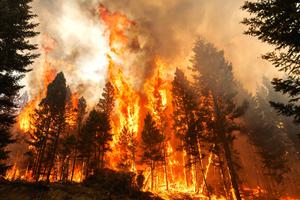This January photo shows a North Atlantic right whale mother and calf in waters near Wassaw Island, Georgia. Associated Press
Critically endangered North Atlantic right whales gave birth to the largest number of calves in six years, offering a glimmer of hope for a population that has been driven to the verge of extinction because of entanglements with fishing gear and collisions with ships.
Aerial survey teams along the U.S. East Coast spotted 17 right whale calves swimming with their mothers offshore between Florida and North Carolina from December through March, the Associated Press reported.That number equals the total of right whale calves born in the three previous years combined and represents the highest number of births since 2015. In recent decades, North American right whale populations have dropped to an estimated 360 animals; three years ago, the population produced no calves at all.
“What we’re seeing is what we hope will be the beginning of an upward climb in calving that’s going to continue for the next five years,” said Clay George, a wildlife biologist who oversees right whale surveys for the Georgia Department of Natural Resources. “They need to be producing about two dozen calves per year for the population to stabilize and continue to grow again.”
Scientists said one reason for the rebound in births may be that right whale populations have moved to waters with healthier populations of zooplankton after experiencing food shortages in feeding grounds in the Gulf of Maine and Bay of Fundy.
Since 2017, an estimated 34 to 49 right whales have been killed in ship collisions and entanglement with fishing gear.
“If we reduced or eliminated the human-caused death rate, their birth rate would be fine,” Philip Hamilton, a right whale researcher at the New England Aquarium told the AP. “The onus should not be on them to reproduce at a rate that can sustain the rate at which we kill them. The onus should be on us to stop killing.”



